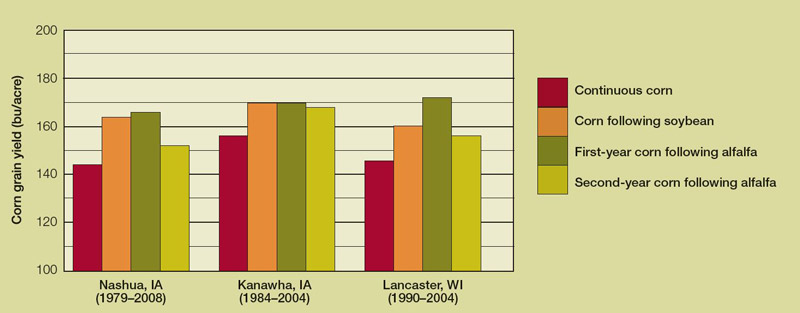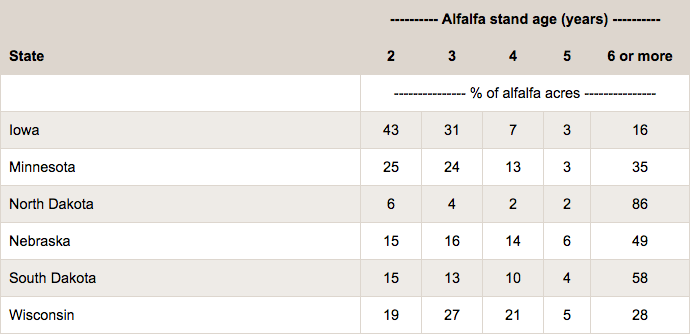Alfalfa provides many benefits to cropping systems. These benefits occur both during alfalfa production and during the subsequent crops that follow. Some of the common benefits during alfalfa production are increased soil organic matter, decreased soil erosion and decreased soil nitrate leaching loss. Alfalfa also usually requires no nitrogen (N) fertilizer and few herbicide applications.
Crops that follow alfalfa usually benefit from: reduced or eliminated N requirement from fertilizer or manure; increased yield potential compared to following other crops (Figure 1); and reduced weed, insect and disease pressure.
Successful termination of alfalfa is essential in order to fully realize the benefits of alfalfa to subsequent corn crops, as volunteer alfalfa competes with corn for water and N.
I. Deciding to Terminate
When possible, the decision about when to terminate alfalfa should be based on economics. Accurate record — keeping of alfalfa establishment costs, production costs, yields, stand quality and value (market or feed) — are essential. Initial alfalfa establishment costs can usually be recovered during the following 1 or 2 production years, but sometimes can be recovered in the establishment year if alfalfa is harvested and its price is high.
 Figure 1. Grain yield for N-fertilized corn grown in various rotations.
Figure 1. Grain yield for N-fertilized corn grown in various rotations.
After the first few production years, alfalfa stand condition and quality can decline at highly variable rates depending on alfalfa genetics, alfalfa management, soil properties, weather conditions, and other factors. This variability makes it difficult to define optimal alfalfa stand lengths across many growing conditions. However, research in Wisconsin, Manitoba and western Canada suggests that net return to alfalfa production often is maximized by rotating alfalfa after an establishment year plus 2-4 production years.
Planned alfalfa termination based on economics is not always possible. Sometimes alfalfa is rotated due to winterkill, weedy or diseased stands, changes in government programs, competition with commodity crops, land needed for applying manure, or other reasons. A survey of 421 Minnesota growers in 2012 found that growers rarely rotate alfalfa according to a planned schedule and that the most common reason for terminating alfalfa was the need for a place to apply manure; 52% of respondents selected this as the top reason for terminating alfalfa. Therefore, increased manure management options, such as increased storage capacity and increased dispersion to other fields, may promote longer alfalfa stands.
The second most common reason for alfalfa termination was thinning alfalfa stands; 36% selected this as the top reason.
Responses were evenly distributed among the remaining reasons for terminating alfalfa, such as weedy alfalfa stands and winterkill. The majority of growers across the Upper Midwest rotate alfalfa after an establishment year plus 2-3 production years according to survey responses from 421 Minnesota growers in 2012 and an analysis of satellite imagery for 2006-2012 (Cropland Data Layers by USDA-National Agricultural Statistics Service). However, in some areas of this region, the majority of stands were rotated after 6 or more years (for example, the western halves of the Dakotas and Nebraska), indicating opportunities for more proactive and frequent rotation of alfalfa to improve net return from alfalfa production (Table 1).
 Table 1. Alfalfa stand age during 2006-2012, according to combinations of Cropland Data Layers. Establishment year stands were not consistently identified in the data layers, so stand age may reflect only production years in some cases.
Table 1. Alfalfa stand age during 2006-2012, according to combinations of Cropland Data Layers. Establishment year stands were not consistently identified in the data layers, so stand age may reflect only production years in some cases.
II. How and When to Terminate
Traditionally, alfalfa stand termination relied on tillage implements such as a moldboard plow or a chisel plow with overlapping sweeps to completely cut off alfalfa roots. Although effective at terminating alfalfa, these tillage implements may not be suitable for all fields due to concerns about soil erosion.
Fall
Advantages to fall alfalfa termination include an earlier start to alfalfa residue decomposition, potential for earlier drying and warming of soil and an earlier corn planting date, and potential for earlier N release during first-year corn. These benefits likely have been realized by growers in Minnesota, because two–thirds of 421 growers in 2012 indicated that they terminated alfalfa in the fall. The major disadvantage with fall termination is that it does not allow for the opportunity to assess whether an alfalfa stand will survive the winter and be productive for another year.
Fall herbicide applications to terminate alfalfa should occur before the first killing freeze (28 F or lower for a few hours), but when new alfalfa regrowth since the last cutting is at least 4-6 inches. Herbicide applied to plants with less than 4 inches of regrowth or to freeze-damaged plants may result in an ineffective kill due to poor herbicide translocation to roots.
To determine if a killing freeze occurred, use the fingerprint test on the morning after a freeze — if your fingerprint remains after squeezing alfalfa leaves between your fingers, the epidermis of the leaves has ruptured due to a killing freeze.
A highly effective herbicide option for fall termination of alfalfa is 2,4–D amine or ester used alone or tank mixed with dicamba products. If grasses are present with alfalfa, a good option is to tank-mix glyphosate with 2,4–D. However, use of high rates of glyphosate alone for alfalfa termination often results in only partial kill (60-90% kill with fall applications, or 40-80% kill with spring applications). Glyphosate will not control alfalfa that is tolerant to glyphosate.
Spring
Advantages to spring termination of alfalfa include the ability to assess alfalfa winter survival and the opportunity for an additional harvest of alfalfa in late May followed by delayed planting of short-season silage or grain corn. Another advantage is soil cover to prevent erosion during winter months. Disadvantages to spring termination of alfalfa include delayed decomposition of alfalfa residue and N release during first-year corn, the potential for delayed corn planting, and increased difficulty in terminating alfalfa with the use of herbicides.
Spring termination of alfalfa with herbicide can be challenging because the optimal time to plant corn typically occurs before alfalfa regrowth is greater than 4-6 inches. When herbicides are used pre-emergence, glyphosate tank-mixed with dicamba and 2,4–D provides consistent control. However, typical dicamba or 2,4–D rates require 2 weeks or more after application before planting corn to reduce the chance of crop injury during emergence.
To control alfalfa post-emergence in corn, products containing 2,4–D or dicamba can effectively control volunteer alfalfa. Products that contain clopyralid also can be used for suppression before or after corn planting. Be aware that the time available for application is short and corn injury can occur if the herbicide labels are not followed.
Also, injury to non–target crops such as soybean can occur from volatilization of many post-emergence growth-regulator herbicides. Relying solely on a post-emergence herbicide program to terminate alfalfa is discouraged due to increased risk of crop injury and incomplete alfalfa kill.




Post a comment
Report Abusive Comment